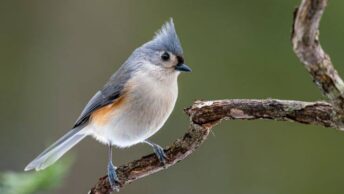The snowy albatross has the widest wingspan of any living bird, reaching 3.7 meters (12.1 feet). The kori bustard is the heaviest flying bird, at 19 kilograms (41.9 pounds), while the sarus crane is the tallest, standing 1.8 meters (5.9 feet). Each species has evolved unique adaptations for flight, from dynamic soaring to powerful takeoffs.
This article ranks the world’s largest flying birds by wingspan, weight, and height. The list is based on the highest verified measurements recorded from wild individuals, using reliable field data. Only birds capable of sustained, powered or soaring flight are included, ensuring that each species here truly represents the upper limits of what is possible in the air.
Snowy Albatross
Diomedea exulans
- Wingspan: As wide as 3.7 m (12.1 ft).
- Weight: As heavy as 12.7 kg (28 lb).
- Body length: Up to 135 cm (53.1 in).
- Where found: Breeds on remote subantarctic islands and ranges widely across the Southern Ocean into subtropical waters.
- Conservation status: Vulnerable; declining due to longline fishing bycatch and other human impacts.
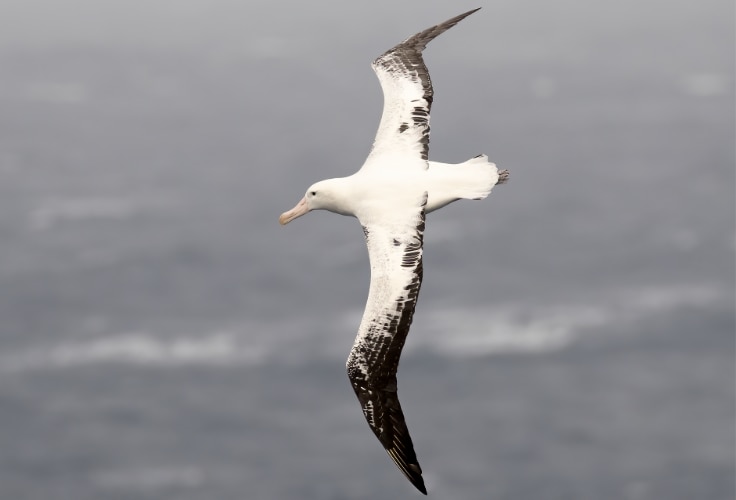
The snowy albatross holds the record for the largest wingspan of any living bird. Exceptional males can reach 3.7 meters (12.1 feet) across the wings, with unverified historical claims of over 4 meters (13 feet) and even 5 meters (16 feet). These immense wings allow it to travel extraordinary distances with minimal wingbeats, making it the ultimate long-distance flyer of the open ocean.
Adapted for dynamic soaring, the snowy albatross can use wind gradients over the waves to glide for hours without flapping. It is capable of circumnavigating the globe in under two months and maintaining speeds of up to 130 kmh (81 mph) for hours at a time. Its low wing loading enables effortless cruising in the strong winds of the Southern Ocean, but it avoids prolonged flapping to limit strain on its wings.
This species breeds on remote islands such as South Georgia, Crozet, Kerguelen, Macquarie, and Marion, nesting on exposed slopes or boggy ground with sparse vegetation to allow easy takeoff. Outside the breeding season, it disperses widely between 30° and 50° south, sometimes straying into the subtropics and occasionally even into the Northern Hemisphere. Its diet consists mainly of squid, supplemented by fish, crustaceans, and carrion.
The main threats to the snowy albatross come from incidental capture in commercial longline and trawl fisheries, particularly off southern Brazil and in the Southern Ocean. Historical hunting for bait and the introduction of predators to breeding islands have also caused losses. While some populations have benefited from fishery waste, the overall trend remains downward, and international conservation agreements focus on reducing bycatch and protecting key breeding sites.
Great White Pelican
Pelecanus onocrotalus
- Wingspan: As wide as 3.6 m (11.8 ft).
- Weight: As heavy as 15 kg (33.1 lb).
- Body length: Up to 180 cm (70.9 in).
- Where found: Large freshwater and brackish wetlands across southeastern Europe, parts of Asia, Africa, and northwestern India.
- Conservation status: Least Concern; stable or increasing in some regions.
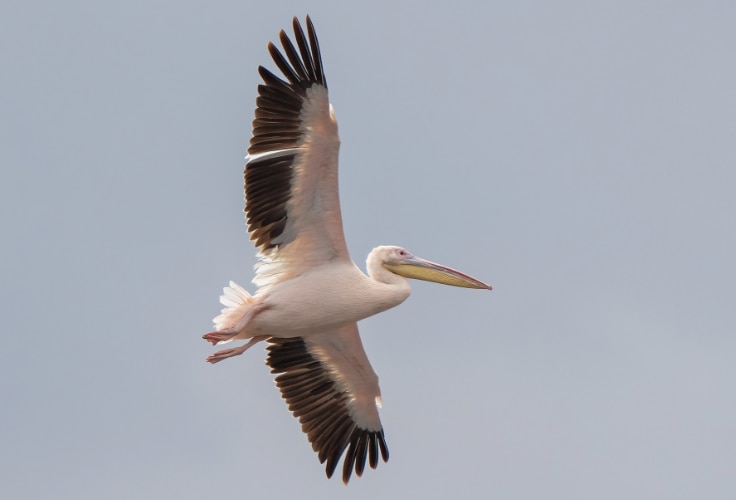
The great white pelican is a large waterbird, known for its broad wings, extremely large bill and striking white plumage. Huge males can reach a wingspan of 3.6 meters (11.8 feet) and weigh up to 15 kilograms (33.1 pounds).
While these record sizes exceed those of any other pelican, the Dalmatian pelican (Pelecanus crispus) is the largest on average. This is likely due to the great white pelican’s stronger sexual dimorphism, with males sometimes up to 30% heavier than females, compared to the more evenly sized Dalmatian.
Despite their bulk, great white pelicans are powerful flyers capable of traveling hundreds of kilometers daily between nesting and feeding sites. Large flocks are a spectacular sight on migration, with synchronized gliding and slow, deep wingbeats that carry them efficiently over long distances.
The species breeds in large colonies on low islands, reedbeds, or rocky outcrops, often in remote wetlands. It occurs from southeastern Europe and western Asia east to Kazakhstan and locally in northwestern India, as well as across much of sub-Saharan Africa. Favored habitats are shallow, warm waters where fish are abundant. Typical prey includes carp in Europe, cichlids in Africa, and other medium-sized fish, though smaller prey may be taken when necessary.
Although still numerous in Africa and stable in parts of Europe and Asia, some populations have declined due to wetland drainage, overfishing, pollution, and disturbance at breeding colonies. In certain regions, they are persecuted as competitors at fish farms. Additional threats include flooding of nests from fluctuating water levels, collisions with power lines during migration, and possible future risks from expanding wind farms.
Andean Condor
Vultur gryphus
- Wingspan: As wide as 3.3 m (10.8 ft).
- Weight: As heavy as 15 kg (33.1 lb).
- Body length: Up to 130 cm (51.2 in).
- Where found: Andes Mountains from Venezuela to Tierra del Fuego, with occasional movements to coasts and plains.
- Conservation status: Vulnerable; declining in much of its range due to persecution, poisoning, and habitat pressures.

The Andean condor is the largest land bird capable of flight and the world’s largest raptor, combining a vast wingspan with a powerful build. Males can reach 3.3 meters (10.8 feet) across the wings and weigh up to 15 kilograms (33.1 pounds), with averages among the highest for any bird.
The species has long, broad wings with the largest surface area of any living bird, an adaptation that allows it to soar at high altitudes and over vast distances with minimal effort. It specializes in gliding, using thermal and orographic updrafts to stay aloft for hours without flapping. Its broad wings and low wing loading enable it to range across immense areas in search of food, often traveling between mountain ranges and coastal regions.
The Andean condor ranges along the Andes from Venezuela to the southern tip of South America, favoring open, mountainous terrain above treeline but also descending to grasslands, deserts, and shorelines where carrion is available. Its diet consists mainly of large mammal carcasses such as guanacos and livestock, along with marine mammals and seabirds, and it often dominates carcasses while smaller scavengers wait their turn.
The species has declined sharply in the northern Andes and is now exceedingly rare in Venezuela and Colombia, where reintroduction programs have had limited success. The main threats include persecution over alleged livestock predation, poisoning, collisions with power lines, and lead ingestion from ammunition.
Marabou Stork
Leptoptilos crumenifer
- Wingspan: As wide as 3.2 m (10.5 ft).
- Weight: As heavy as 9 kg (19.8 lb).
- Body length: Up to 1.52 m (5 ft).
- Where found: Open savannas, grasslands, wetlands, and human-altered areas across most of sub-Saharan Africa.
- Conservation status: Least Concern; widespread and in many areas increasing due to human-generated food sources.
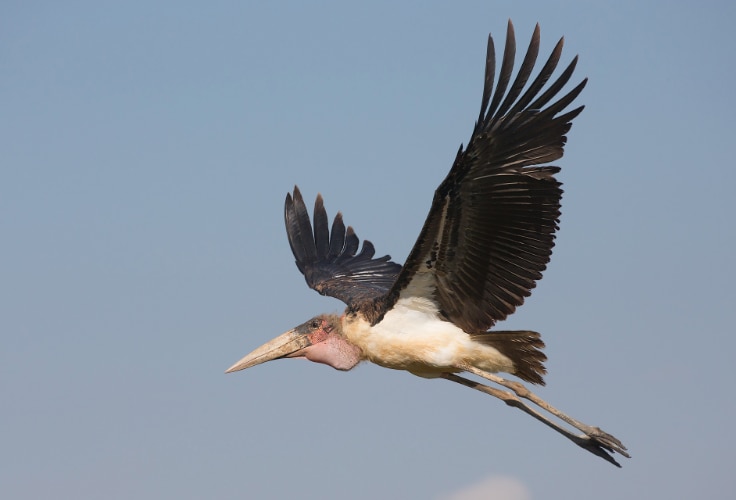
The marabou stork is the world’s largest stork and the widest-winged bird in Africa, with wingspans reaching up to 3.2 meters (10.5 feet). Higher measurements of up to 4 meters (13.1 feet) have been reported but remain unverified. Despite its size, the marabou stork is a capable and sustained flyer, soaring high on thermal currents in search of food.
The species occurs across most of sub-Saharan Africa, from Senegal and Ethiopia south to Namibia and northeastern South Africa, inhabiting open country such as dry savannas, grasslands, wetlands, riverbanks, and lake shores. It breeds colonially near wetlands on tall trees or artificial structures, and its diet is highly opportunistic, including carrion, scraps from human activity, fish, insects, small mammals, and reptiles.
The marabou stork remains widespread and adaptable, and in many regions its population is stable or increasing thanks to abundant refuse and human-provided food sources. In some areas, cultural beliefs protect the species, and its role in cleaning up waste is recognized as valuable. Potential threats are mostly local, including habitat alteration and disturbance at breeding sites, but overall it continues to thrive across much of its range.
Cinereous Vulture
Aegypius monachus
- Wingspan: As wide as 3.1 m (10.2 ft).
- Weight: As heavy as 14 kg (30.9 lb).
- Body length: Up to 120 cm (47.2 in).
- Where found: Mountains, plateaus, steppes, and semi-arid habitats across southern Europe, North Africa, the Middle East, and much of Central and East Asia.
- Conservation status: Near Threatened; threatened by poisoning, habitat loss, and collisions with power lines and wind turbines.
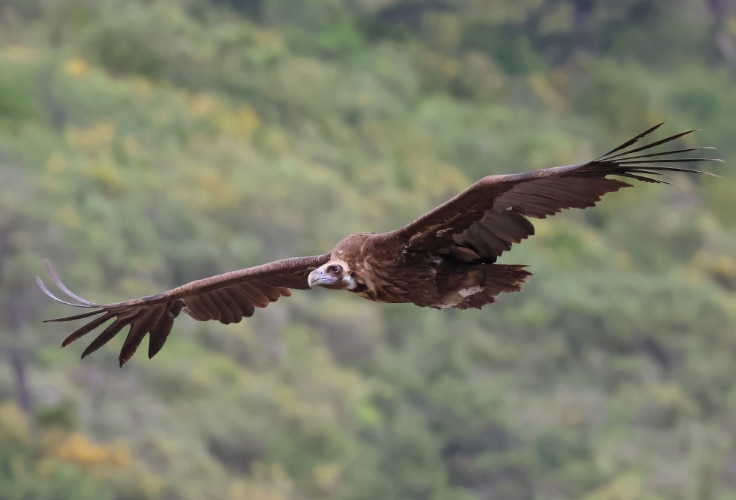
The cinereous vulture is the largest Old World vulture and one of the world’s broadest-winged raptors, with wingspans reaching 3.1 meters (10.2 feet). Females can weigh up to 14 kilograms (30.9 pounds), making it one of the heaviest flying birds on the planet.
This huge bird is a skilled and energy-efficient flyer, soaring on thermals for hours with minimal wingbeats. It often searches for food from high altitude, then descends in long glides to carcasses in open country. Its powerful build make it a dominant presence at feeding sites, capable of displacing smaller scavengers.
The cinereous vulture occurs from the Iberian Peninsula and southeastern Europe through the Middle East and Central Asia to Mongolia, China, and the Korean Peninsula. It inhabits a variety of open and semi-open landscapes, including mountain plateaus, steppes, semi-deserts, and lightly forested slopes. Its diet consists mainly of carrion from medium- to large-sized mammals, but it may also feed on smaller vertebrates when necessary.
Although still widespread, the cinereous vulture faces ongoing threats across its range. Accidental poisoning from poisoned baits and veterinary drugs, habitat degradation, electrocution on power lines, and collisions with wind turbines continue to cause mortality. Conservation measures include strict legal protection, habitat preservation, anti-poisoning campaigns, and reintroduction projects in parts of Europe.
Trumpeter Swan
Cygnus buccinator
- Wingspan: As wide as 3.1 m (10.2 ft).
- Weight: As heavy as 17.2 kg (37.9 lb).
- Body length: Up to 183 cm (72 in).
- Where found: Large lakes, marshes, and slow rivers across Alaska, Canada, and parts of the northern United States.
- Conservation status: Least Concern; recovered from historic declines.
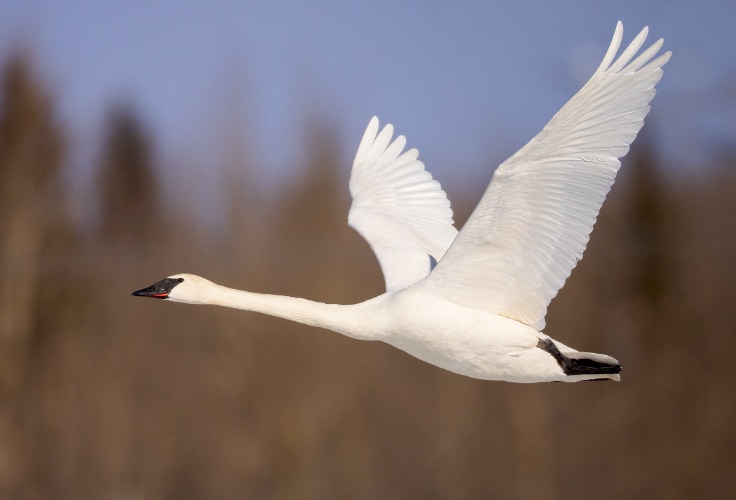
The trumpeter swan is the heaviest waterfowl in the world and among the largest birds in North America. Exceptionally large males can span 3.1 meters (10.2 feet) across the wings and weigh over 17 kilograms (37.9 pounds).
While a mute swan (Cygnus olor) cob has been reported at 22.5 kilograms (49.6 pounds), this was an outsized specimen of questionable flight capability. On average, trumpeter swans are heavier than any other waterfowl species.
Despite their bulk, trumpeter swans are strong flyers, capable of long-distance migrations between breeding and wintering grounds. They require long stretches of open water for takeoff, running across the surface before lifting into the air.
The trumpeter swan breeds across Alaska, much of Canada, and parts of the northern United States, and winters locally in the Pacific Northwest, interior western states, and scattered sites farther south. It nests on large freshwater lakes, ponds, marshes, and slow-flowing rivers, favoring shallow waters rich in aquatic vegetation. Its diet consists mainly of submerged plants such as pondweeds and waterweeds, supplemented by grasses, grain, and occasional invertebrates.
Once reduced to a few remnant flocks in North America, the trumpeter swan has made a remarkable recovery through legal protection, wetland conservation, and widespread reintroduction efforts. It is now found across much of its former range, though some populations remain small and vulnerable.
Himalayan Griffon
Gyps himalayensis
- Wingspan: As wide as 3.1 m (10.2 ft).
- Weight: As heavy as 12.5 kg (27.6 lb).
- Body length: Up to 115 cm (45.3 in).
- Where found: Mountains and high plateaus from northern Pakistan and India across Tibet and Nepal to Bhutan, China, and Central Asia.
- Conservation status: Near Threatened, with localized declines but stable or recovering in some regions.
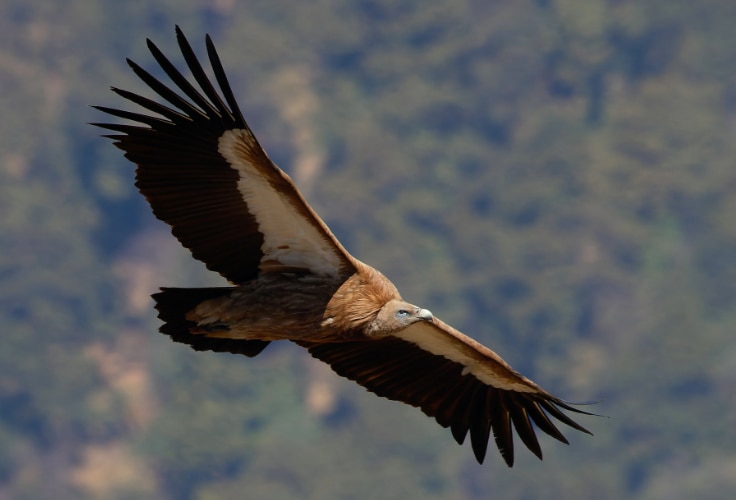
The Himalayan griffon is the largest of the griffon vultures and the most powerful flying bird of the Himalayan region. Its wingspan can reach 3.1 meters (10.2 feet), matching the biggest Old World vultures.
This broad-winged raptor is built for life at extreme elevations, where thin air and rugged landscapes demand strength, stamina, and efficient soaring. It spends hours circling on thermals, conserving energy while scanning vast mountain valleys and plateaus for carrion, and at carcasses it dominates all other vultures except the cinereous vulture, feeding aggressively in noisy gatherings where competition is intense.
Its range spans the high mountains from northern Pakistan and India through southern Tibet and Nepal to Bhutan and central China, also extending northeast through the Pamirs and Tien Shan. It is typically found between 1,500 and 4,000 meters (4,900-13,100 feet), occasionally reaching 6,000 meters (19,700 feet), and winters at somewhat lower altitudes. The diet is almost entirely carrion, often livestock in the Himalayas and Tibetan Plateau, especially domestic yaks.
Once considered secure in much of its range, the Himalayan griffon has suffered declines due to ingestion of livestock carcasses treated with the veterinary drug diclofenac, which is lethal to vultures. These declines have been most severe in Nepal and parts of India, but populations on the Tibetan Plateau remain strong, partly thanks to protection and cultural reverence, including their role in traditional sky burials.
California Condor
Gymnogyps californianus
- Wingspan: As wide as 3.05 m (10 ft).
- Weight: As heavy as 14.1 kg (31.1 lb).
- Body length: Up to 140 cm (55.1 in).
- Where found: Open grasslands, scrublands, and montane regions of California, Arizona, Utah, and Baja California, Mexico.
- Conservation status: Critically Endangered; population recovering through intensive management but still reliant on conservation programs.
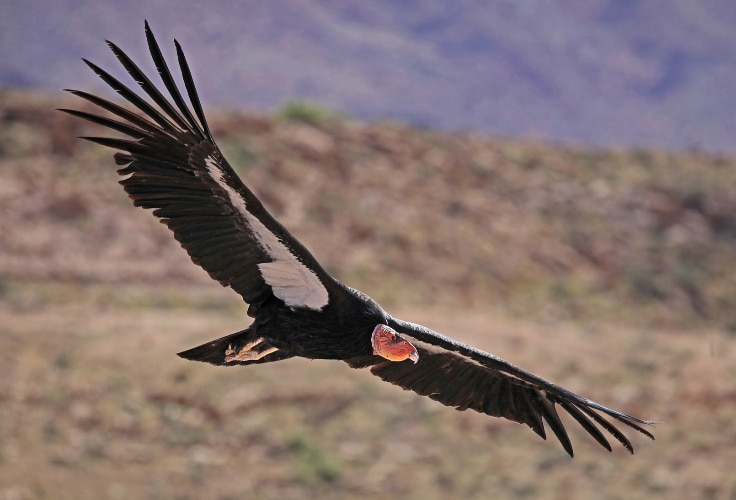
The California condor is the largest land bird in North America and consistently holds the widest wingspan on the continent. Huge individuals can reach wingspans of 3.05 meters (10 feet), with exceptional, though unverified, reports of up to 3.4 meters (11.2 feet).
Condors are masters of soaring, using thermal and orographic updrafts to remain aloft for hours while searching vast areas for carrion. They rely on their immense wings to glide efficiently over ridges, cliffs, and coastal slopes, rarely flapping except during takeoff or landing.
Once widespread across much of North America, the California condor now occupies a much smaller range, with wild populations established through reintroduction programs in California, Arizona, Utah, and Baja California. It inhabits open country with reliable wind currents, foraging mainly in grasslands, savannas, and along coastal areas. Its diet consists almost entirely of mammalian carrion, both wild and domestic, with occasional use of marine mammal remains along the Pacific coast.
By 1987, the species was extinct in the wild, with only 27 individuals surviving in captivity. Intensive conservation efforts, including captive breeding, lead reduction programs, and supplemental feeding, have since increased the global population to 566 individuals as of 2025, with 369 living in the wild.
Major threats remain – most critically lead poisoning from spent ammunition, as well as micro-trash ingestion, collisions with power lines, and emerging disease risks. Despite the remarkable recovery, the species long-term survival depends on continued management, habitat protection, and sustained public and legislative support.
Sarus Crane
Antigone antigone
- Wingspan: As wide as 2.8 m (9.2 ft).
- Weight: As heavy as 12.3 kg (27.1 lb).
- Height: As tall as 1.8 m (5.9 ft).
- Where found: Wetlands, floodplains, and agricultural fields across the Indian subcontinent, Southeast Asia, and northern Australia.
- Conservation status: Vulnerable; declining due to wetland loss, disturbance, and hunting in much of its range.
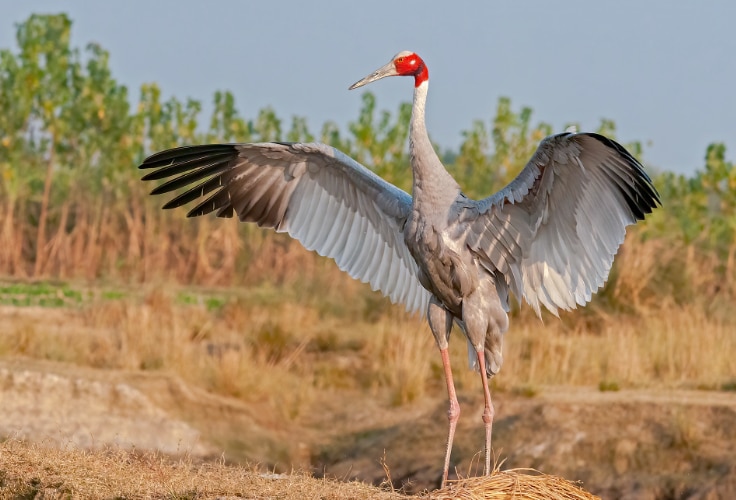
The sarus crane is the world’s tallest flying bird, with large individuals standing up to 1.8 meters (5.9 feet) in height. Northern populations tend to be larger than those in Southeast Asia and Australia, but across its range it remains an impressive sight.
The species inhabits wetlands, floodplains, and agricultural landscapes across the Indian subcontinent, parts of mainland Southeast Asia, and northern Australia. It uses both natural and human-modified habitats, foraging in marshes, flooded grasslands, rice paddies, and crop fields. Its varied diet includes tubers, grains, seeds, insects, crustaceans, and small vertebrates, taken while walking slowly with head lowered.
Populations are declining in much of the range due to loss and degradation of wetlands from agriculture, drainage, development, and pollution. Additional threats include disturbance, egg collection, chick capture, and occasional hunting. Power line collisions and pesticide use also contribute to mortality. Conservation measures include legal protection, habitat management, and community-based programs, with notable successes in parts of India, Nepal, and Vietnam.
Kori Bustard
Ardeotis kori
- Wingspan: As wide as 2.75 m (9 ft).
- Weight: As heavy as 19 kg (41.9 lb).
- Height: As tall as 1.37 m (4.5 ft).
- Where found: Open grasslands, savannas, and semi-arid regions of eastern and southern Africa.
- Conservation status: Near Threatened; declining due to habitat loss, hunting, and collisions with power lines.
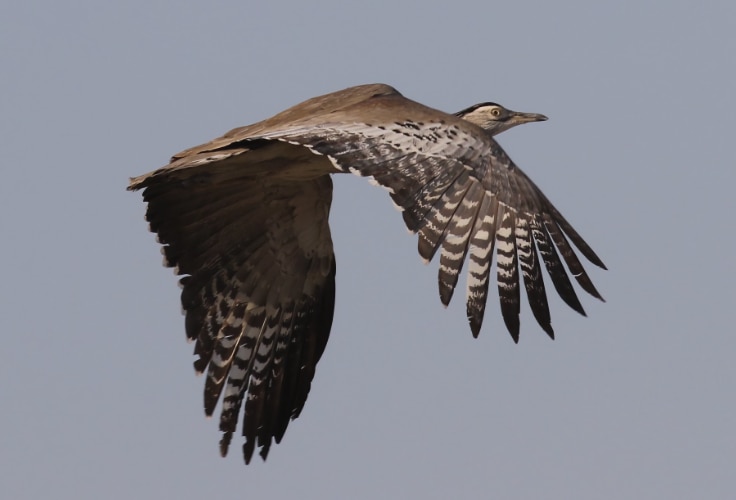
The kori bustard is the world’s heaviest flying bird, with large males reaching 19 kilograms (41.9 pounds). While a great bustard (Otis tarda) from Manchuria was once reported at 21 kilograms (46.3 pounds), its health and ability to fly remain uncertain. Across individuals, the kori bustard averages larger and heavier than its Eurasian relative.
Kori bustards are primarily ground-dwelling, walking with slow, deliberate strides and relying on camouflage and vigilance rather than speed to avoid danger. They take to the air only occasionally, as lifting their bulk requires considerable effort. These imposing birds can reach 1.37 meters (4.5 feet) in height, making them one of the most iconic species of Africa’s grasslands.
The species ranges across eastern Africa from Somalia to northern Tanzania and through southern Africa from Angola and Namibia to South Africa. It favors flat, open habitats with short grass or sparse scrub, sometimes moving into woodland in the dry season. Bustards feed on a wide range of foods, from seeds and berries to insects, small reptiles, and carrion, often gathering in areas rich in locusts or flushed prey after fires.
Despite their wide range, populations are declining due to habitat degradation from overgrazing, disturbance, hunting, and road mortality. Collisions with power lines are a serious problem, especially in South Africa’s Karoo region, where hundreds are killed annually. Their limited binocular vision leaves a blind spot ahead, making them particularly vulnerable to hitting cables. Conservation efforts focus on habitat protection and mitigating infrastructure hazards.
Largest Birds Ever to Take Flight
While modern giants like the snowy albatross or kori bustard push the limits of flight, they are still outmatched by some extinct species.
The largest known flying bird, the seabird Pelagornis sandersi, likely spanned up to 7.4 meters (24.3 feet) across the wings – nearly twice the maximum of the snowy albatross. The heaviest known flyer, Argentavis magnificens of Miocene Argentina, may have weighed up to 80 kilograms (176.4 pounds), relying on soaring rather than flapping to stay aloft. While older studies proposed slightly greater sizes, more recent research supports these figures as the most accurate.
These prehistoric giants highlight just how exceptional today’s largest fliers are, and how remarkable it is that such size and sustained flight can coexist at all.


